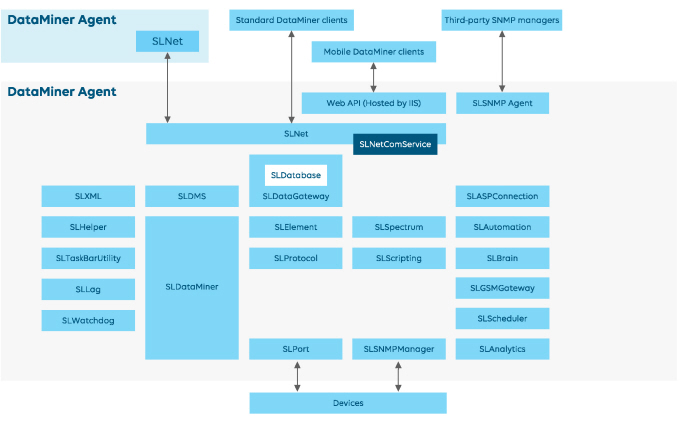DataMiner processes
A DataMiner Agent hosts a number of separate but interacting processes.
Graphical overview of the processes running on a DataMiner Agent
The following overview clearly shows how the DataMiner Agent software is a collection of separate but interacting processes.
Overview of the DataMiner Agent processes

Main DMA software components
Below, you can find more information on the main DataMiner processes.
For information on the auxiliary processes, see Auxiliary DMA software components
SLDataMiner
The central process of a DataMiner Agent.
Starts, stops and configures elements, services, redundancy groups, and manages all traffic from and to those items.
Performs database offloads toward the offload database (if one exists).
Note
This process is not aware of any other DMAs in the DataMiner System.
SLDataGateway
This process calculates the average trending information.
If a Cassandra database or Cassandra-compatible database is installed, this process also handles the following:
All communication with that database (communication with legacy databases happens via SLElement).
The building of time traces, used for heat maps.
Transfer of data to the SLAnalytics process.
SLDMS
Takes care of file synchronization within the DataMiner System, triggers connections, etc.
Initiates communication with other DMAs in the DMS. The communication itself, however, is managed by SLNet.
SLElement
Keeps track of parameter values that have to be shown to the user and creates alarms.
On compatible systems, SLElement is run as a 64-bit process. However, it can still be run as a 32-bit process if it is registered as such with a batch file from the Tools directory.
Note
This process is only aware of parameters that are being monitored and parameters that have to be displayed on the user interface.
SLLog
Manages all interaction with the different log files found in the DataMiner System.
SLNet
Controls all communication among DataMiner Agents, and between DataMiner Agents and their clients.
Tip
See also: Configuring SLNet settings in MaintenanceSettings.xml
Note
Data for trend data queries is cached in the SLNet process after it has been received from SLDataGateway and before it is processed further. In the SLNetClientTest tool, several options are available related to the trend cache. However, note that this is an advanced system administration tool that should be used with extreme care. See Configuring trend caching.
SLPort
Controls all communication from and to devices connected to either a serial port or an IP port.
Types of communication controlled by this process include serial, smart-serial, GPIB and OPC.
Note
Multiple SLPort processes can run simultaneously. See Setting the number of simultaneously running SLPort processes.
SLProtocol
Executes the instructions specified in DataMiner protocols.
Note
Multiple SLProtocol processes can run simultaneously. See Setting the number of simultaneously running SLProtocol processes.
SLSNMPManager
Controls all communication from and to SNMP devices acting as SNMP agents.
Tip
SLWatchdog
Monitors all other DataMiner processes and takes action
when a DataMiner process has disappeared from the list of running processes, or
when an anomaly has been detected in a DataMiner processes.
It also keeps track of a number of key performance indicators.
Auxiliary DMA software components
Below, you can find more information on the auxiliary DataMiner processes.
For information on the main processes, see Main DMA software components.
SLAnalytics
This process only starts on a DMA that uses Storage as a Service or a Cassandra-compatible database. It supports advanced artificial intelligence functions in DataMiner, such as trend forecasting, anomaly detection, and alarm focus calculation.
SLASPConnection
The DMS Reporter process.
Tip
See also: DMS Reporter
Note
- Timeline data that are received from SLDataGateway or directly from a MySQL database are cached in the SLASPConnection process. Some caching options can be configured in MaintenanceSettings.xml. See MaintenanceSettings.xml.
- You can also find more information and settings for timeline caching at http(s)://[DmaIp]/Reports/Tools.asp:
- The page displays timeline cache statistics and list contents.
- The expiration time, grace time and maximum number of records can be set here, but only for the current session. These settings can be permanently changed in MaintenanceSettings.xml.
- Timeline caching and timeline cache verbose logging can be enabled and disabled on this page, or directly in MaintenanceSettings.xml.
SLAutomation
The DataMiner Automation process.
Note
C# code in Automation scripts is processed by SLAutomation, whereas C# code in protocol QActions is processed by SLScripting.
Tip
See also: DataMiner Automation
SLBrain
Deprecated. Legacy DataMiner Correlation process.
Note
This process is only available in DataMiner versions prior to DataMiner 10.5.1/10.6.0.
SLGSMGateway
The DataMiner Mobile Gateway process.
Sends and receives SMS messages (i.e. text messages).
Tip
See also: DataMiner Mobile Gateway
SLHelper
A helper process that is called upon by other processes to perform actions such as
converting a Microsoft Visio drawing to an image file (e.g. to allow Visio drawings to be rendered in web apps),
converting documents (e.g. reports) to PDF format,
etc.
SLNetComService
Translates so-called managed code (as used by e.g. SLNet) to native code (as used by e.g. SLDataMiner) and vice versa.
SLScheduler
A helper process that is called upon when the Windows Task Scheduler orders that a scheduled task has to be performed.
SLScripting
Processes QActions when asked to by SLProtocol.
Note
C# code in Automation scripts is processed by SLAutomation, whereas C# code in protocol QActions is processed by SLScripting.
SLSNMPAgent
Communicates with third-party applications acting as SNMP managers (e.g. HP OpenView, IBM NetCool, etc.).
Also sends all outgoing email notifications.
Tip
SLSpectrum
The DataMiner Spectrum Analysis process.
Also manages the time slots assigned to each of the clients that want to use a particular spectrum analyzer.
Tip
See also: DataMiner Spectrum Analysis
SLTaskBarUtility
The DataMiner system tray utility that allows you to easily start, stop, backup, restore and upgrade a DMA.
SLXML
Manages all interaction with the different XML files found in the DataMiner System.